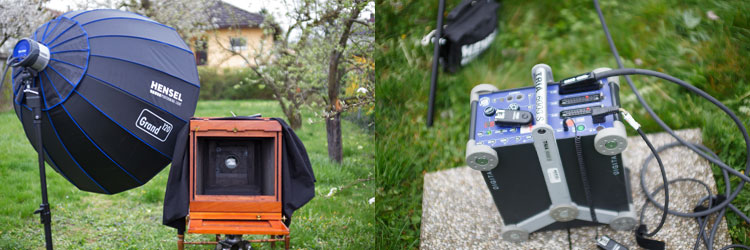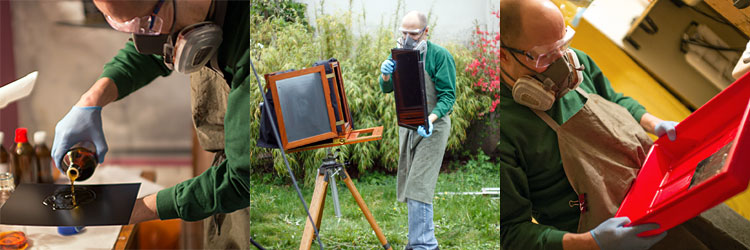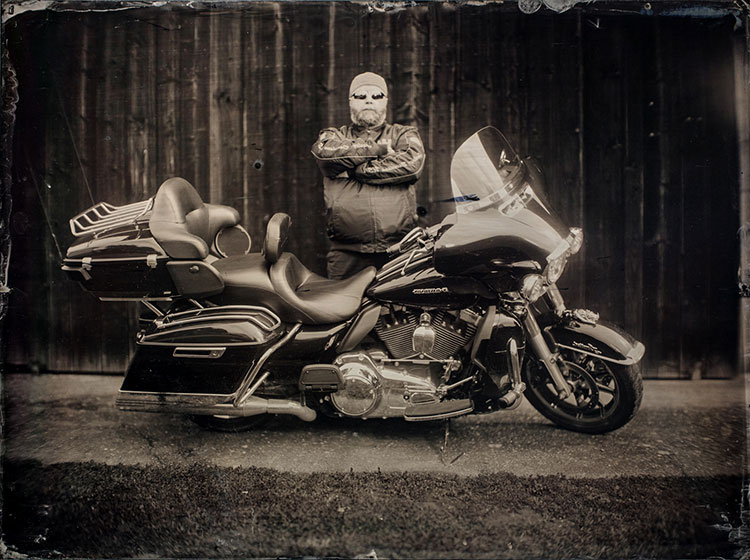Special photos for unique moments: Wet plate photography with Tria 6000 S
Photographer Markus Hofstaetter from Austria revives a historic photographic process – the collodion wet plate photography – which goes straight to the hearts of photo nostalgists and other fans of hand-made photography alike.
Leo, a passionate biker from Vienna, recently bought a brand new Harley Davidson. This, he thought, is the ideal occasion for very special photos. So Markus took on the task to capture the new motorcycle and the proud owner “on plate”.
HOW WAS IT DONE?
With accuracy & skills
First, an aluminium plate is coated with the collodion, which consists of cotton, alcohol, ether and two kinds of salt (in this case, cadmium and ammonium) by pouring it evenly on the plate. As soon as a film forms, the plate has to be dipped into a silver nitrate bath. Through this procedure, the salts are turned into silver salts, which make the plate light-sensitive.
Now comes the even trickier part
Since the plate has to stay moist during exposure, every minute counts: Put the plate into a light-tight cartridge, insert cartridge into the historic field camera, open cartridge und remove the lens cap, trigger a flash, reattach the lens cap, close the cartridge and bring it immediately to the darkroom for development.
The developing bath consists of vinegar, alcohol and iron sulphate. In the last step, the exposed and developed plate is prepared in the fixer for “eternity”. A truly unique keepsake!
MORE LIGHT!
The prepared wet plates have a relatively low light sensitivity, so very much light is needed for every photo. Markus uses our Hensel Tria 6000 S flash generator, which provides up to 6000 Ws per flash triggering for the dedicated Hensel EH Pro 6000 flash head.
A Grand 90 Softbox was used here as the light modifier (without inner and front diffuser), so that the final image becomes rich in contrast and luminance.
The lighting set-up was positioned to the left of the camera, so that the light comes slightly from the side and creates additional vividness.
For a better evaluation of the light quantity and distribution, as well as the position of the model and the bike, Markus took a digital test shot in advance – so that the first exposure of the wet plate will be an immediate success!
To get a perfect result, the model himself also plays a crucial part: Standing perfectly still is absolutely necessary. The exposure time of this photo was a little over a second, so that the daylight is able to make the final image a bit ‘softer’. How much influence the daylight had on this shot, is well visible on the wooden background of the following result.
The result makes us as happy as photographer Markus and bike owner leo themselves:
MAKING-OF VIDEO
The Austrian TV station ‘ORF’ visited Markus and has made a TV report about this photo shoot – you can watch it on Markus’ website here: http://wetplate.art (video language: German)
About the photographer
Markus Hofstatter is an awarded professional photographer and artist for wet plates, portraits, events, sports and virtual tours. He likes to share his extensive know-how about wet plate photography with others by holding workshops.
Markus lives and works in Muckendorf in Austria.
Discover more about Markus, his work, many more wet plate photographs and see more making-of videos here: http://wetplate.art






